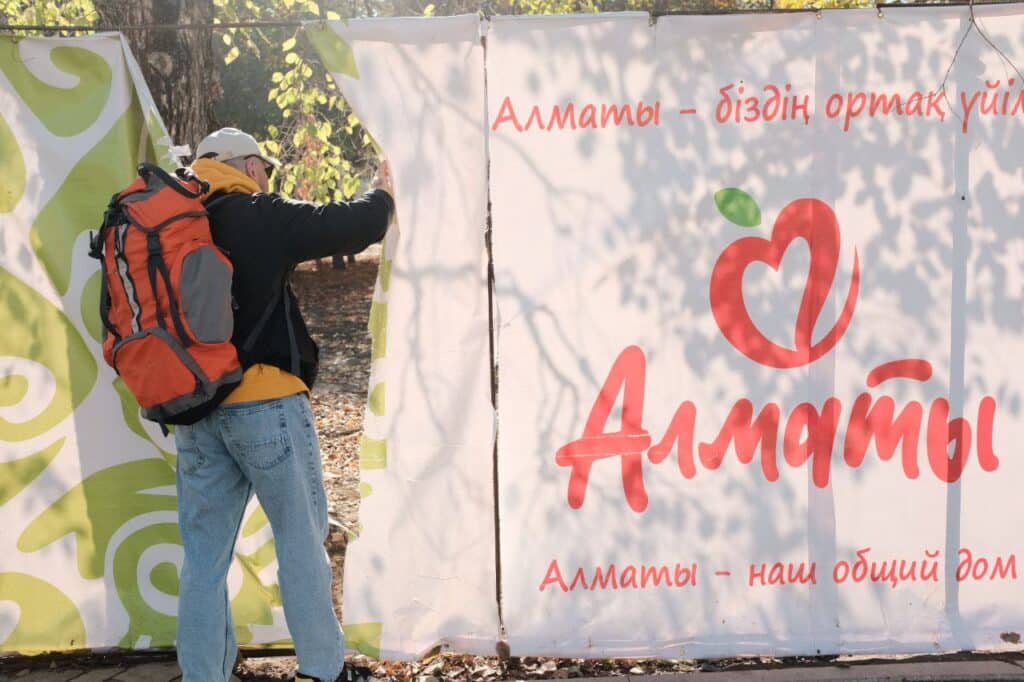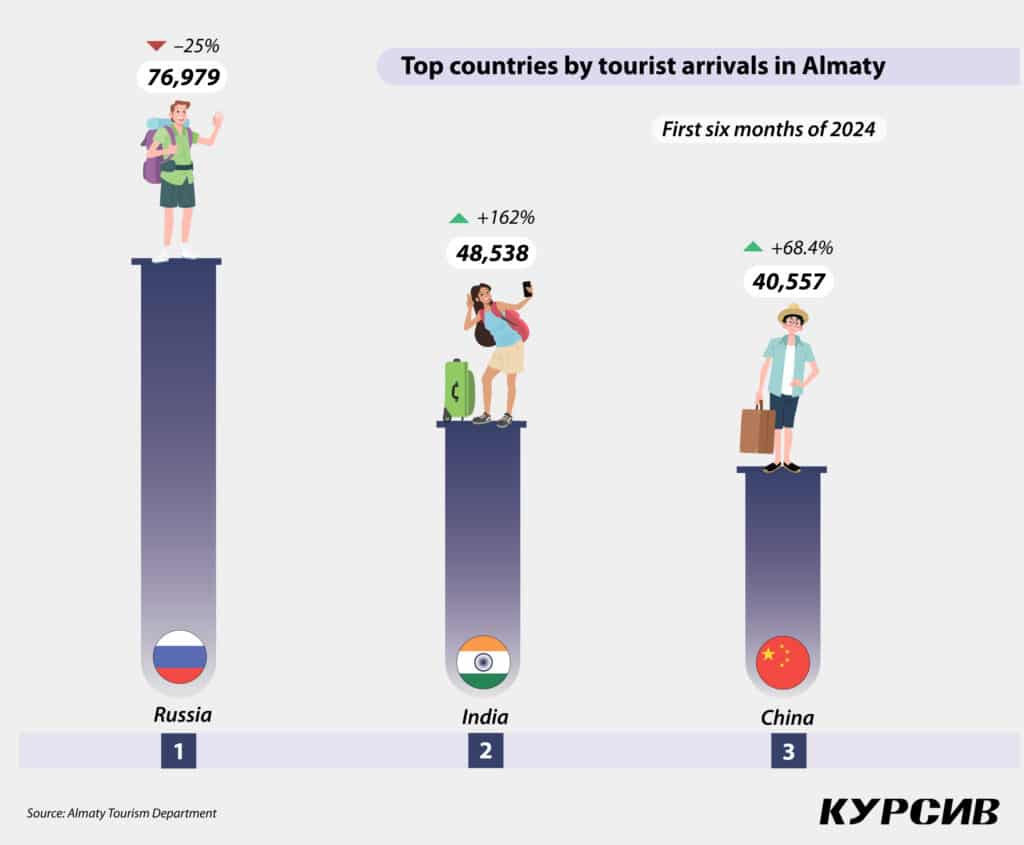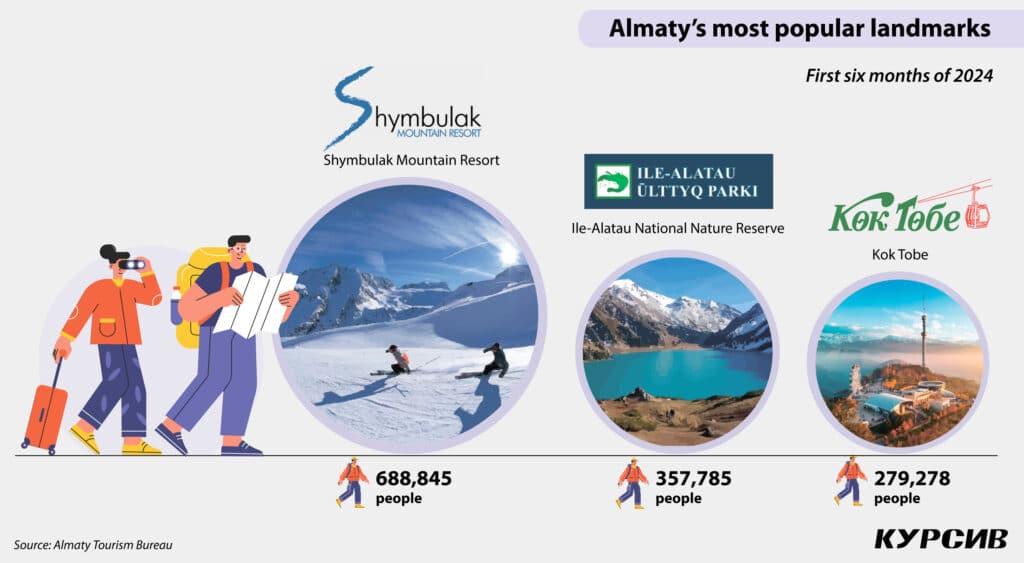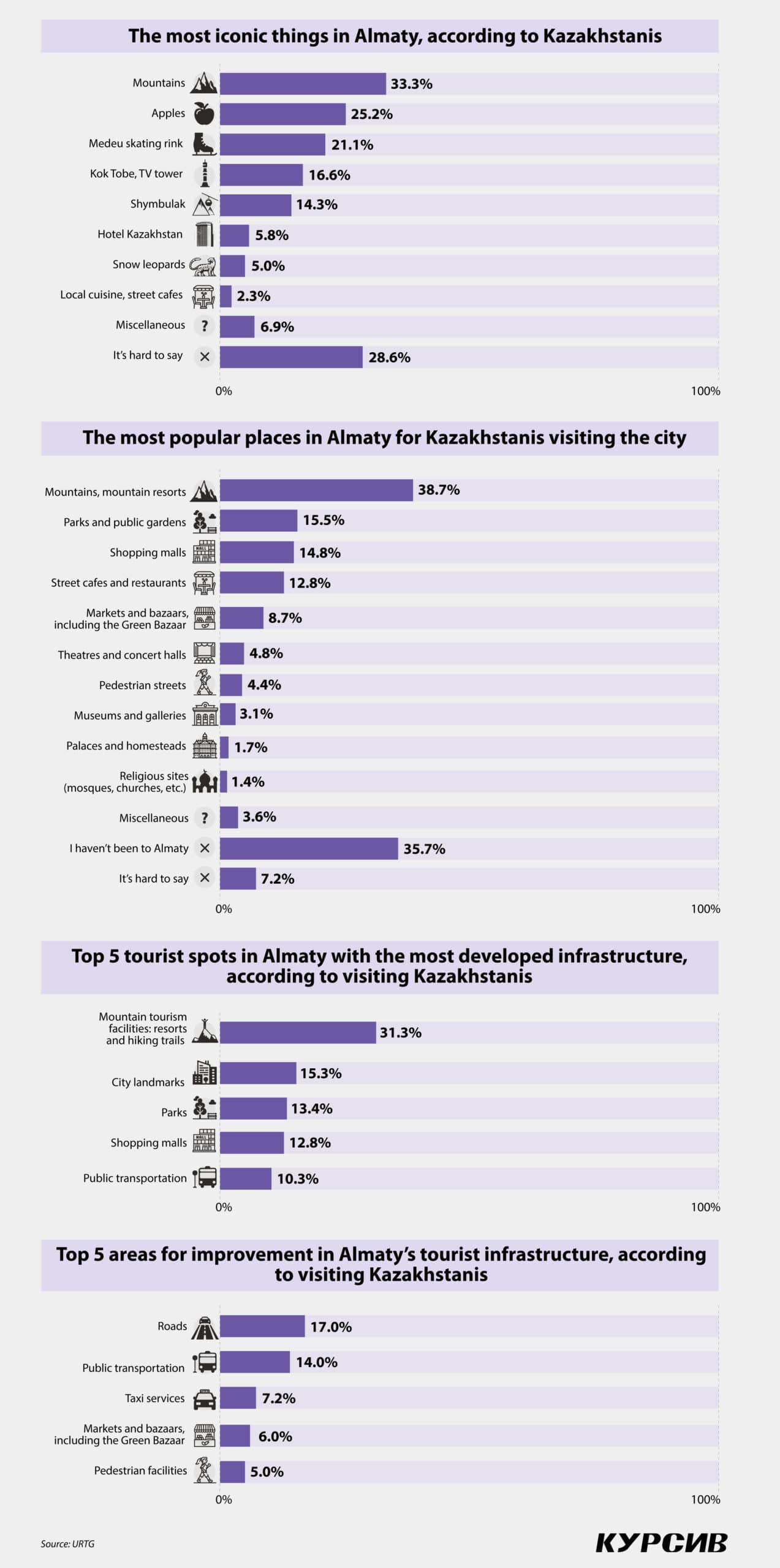Rethinking Almaty: More than a transit city

In 2024, Almaty’s city authorities have earmarked over $4 million to promote tourism. The funds are being allocated to publicize the city internationally through online platforms, domestic media and influencer marketing. However, unresolved urban issues risk making foreign visits to Almaty a one-time experience.
«Almaty is breaking records! Last year, the city became a top destination for tourists worldwide,» reported the Almaty Tourism Department, basing its enthusiasm on the data published by the Bureau of National Statistics (BNS). In 2023, Almaty welcomed over two million tourists, with international visitors making up a quarter (540,700). This year could see even higher numbers; by mid-2024, 1.1 million visitors stayed in local hotels, a 10.1% increase year-on-year (YoY), with international travelers comprising 28% (302,400), up 15.6% YoY.
«These numbers are not only impressive given the challenges of the recent pandemic, but they also reaffirm Almaty’s appeal as a travel destination,» the tourism authority noted.
However, professionals in the tourism industry, who work directly with international visitors, are less optimistic. They highlight the need for significant improvements to meet the expectations of foreign tourists. Currently, Almaty remains more of a transit stop than a primary destination, attracting only a fraction of travelers who specifically plan to explore the city.
The growing inbound tourism
In 2024, Almaty saw a surge in interest from Indian and Chinese tourists, with visits up by 162% and 68.4% YoY, respectively. This trend reflects the launch of direct flights between these countries and Almaty. Since last September, IndiGo, an Indian low-cost carrier, has operated three weekly flights on the Delhi-Almaty route. China Southern Airlines also began flying from Beijing to Almaty three times a week last winter, expanding to daily flights from late April.

Despite a 25% decrease in visits from Russia, Russian tourists still lead in absolute numbers among foreign visitors. According to BNS, in the first six months of 2024, Almaty hotels hosted 77,000 Russian tourists, 48,500 Indian tourists and 40,600 Chinese tourists.
The cost of promotion
Almaty’s promotion, managed by the quasi-governmental Almaty Tourism Bureau (ATB), a subsidiary of the city’s tourism department, has seen a substantial increase in funding.
In 2023, the tourism department allocated $502,000 to the bureau for international marketing efforts and close to $2 million for domestic promotion. This year, the budget has risen to $2.3 million for domestic promotion and $2.4 million for international efforts, underscoring Almaty’s commitment to expanding its global visibility as a travel destination.
The ATB has prioritized digital promotion, selecting the U.S., Turkey, the UAE, France, Germany, Italy and Singapore as key markets for boosting the city’s online visibility. Through targeted and contextual advertising, projected for 123 million impressions, experts estimate Almaty could see returns of approximately $55 million. The bureau has allocated a significant portion — $701,000 or nearly one-third of its international budget — for online advertising in these regions.
An additional 15% of the budget, totaling $329,000, went toward promoting Almaty on major international platforms like TripAdvisor and Expedia.
According to Kamila Lukpanova, CEO of the ATB, the investment has already paid off, generating $335,000 in tour sales via TripAdvisor and $270,000 on Expedia.
Last year’s influencer tours organized by the bureau hosted bloggers from Singapore, the UAE, Turkey, China, Spain, Cyprus and the U.S., resulting in a reach of 35.7 million people and almost 15 million views. According to the Goszakup.kz government procurement portal, these tours cost around $142,000. However, ATB has not disclosed the direct impact of these efforts on tourist arrivals.
Among other significant promotional expenses, the bureau allocated about $400,000 for media ads, $300,000 for three international forums focused on business tourism, $250,000 to produce five branding videos and a virtual 3D tour, $150,000 to create a registry of tourist sites and $100,000 on souvenirs.
Popular destination
«Why is Almaty so popular? The answer is straightforward: it has a unique culture, colorful landscapes and developed infrastructure. This makes the city a place you want to return to,» stated the city’s tourism department.
However, Kazakhstanis — the true bearers of this «unique culture» — only partially agree with this sentiment. A survey by the United Research Technologies Group (URTG) reveals that the largest share of Kazakhstani respondents is primarily drawn to Almaty’s natural attractions. Nearly 39% of respondents visit the southern capital to experience the mountains and enjoy mountain resorts, while 15.5% frequent public gardens and parks. Shopping malls rank third in popularity among local tourists, with 14.8% of respondents citing them as their reason for visiting. According to respondents, the infrastructure at these locations is the most developed.

Conversely, the survey also identified the three least convenient areas for tourists in Almaty: roads (17%), public transportation (14%) and taxi services (7.2%).
Kursiv.media has gathered insights from foreign tourists on social media regarding the most attractive spots in Almaty. Almaty’s mountains and national parks, including Altyn-Emel and Charyn, topped the list of mentions. Additionally, foreign visitors expressed interest in the city’s cultural landmarks, architecture and gastronomy.
«Among the most popular locations that consistently attract visitors to the city, the Shymbulak Mountain Resort stands out as the leader, welcoming 688,845 visitors in the first half of 2024,» Lukpanova noted. «The second most visited destination is the Ile-Alatau National Park, which drew 357,785 visitors. With its hiking trails, glaciers and diverse flora and fauna, this natural reserve is an ideal spot for ecotourism enthusiasts. Following closely is Kok Tobe, known for its panoramic views of the city and various entertainment options, which has attracted 279,278 visitors so far.»
Regarding gastronomy, the ATB reports that tourists appreciate the wide variety of both national and international cuisine available in the city.
«Both non-nomadic and nomadic cuisines are gaining popularity abroad. Every guest can find a dish in Kazakh cuisine that suits their taste. For instance, Italians have shown a particular fondness for horse meat tartare and marrow bones, which remind them of ‘ossobuco,’ a classic Italian dish,» Lukpanova said.
However, visitors have also noted several challenges in Almaty. Chinese tourists report difficulties in finding information and assistance in both Chinese and English. They highlight issues such as infrequent public transport routes, outdated transportation systems, poorly maintained roads and street lighting, insufficient cleanliness in public spaces and air pollution. Tourists from India have raised challenges related to locating familiar food products or restaurants that serve Indian cuisine. Meanwhile, Russian and Turkish visitors express concerns about hotel and cafe prices being too high compared to the level of service provided.
Branding the city
Kazakhstanis have strong associations with Almaty that reflect its unique character and cultural symbols. According to the URTG’s survey polling over 1,600 people from various regions, Almaty is most often associated with mountains. This connection is particularly strong among younger respondents aged 18 to 29 (47.3%) and residents of Almaty, Astana, the Akmola region and Atyrau.
The next most popular symbol is the apple, with 25% of respondents, especially those aged 45 to 59, associating Almaty with the famous Aport apple variety, a nostalgic reference for many in the Almaty region. In third place is the Medeu skating rink, an icon for one in five respondents, particularly for those in Almaty and the Zhetysu region.
Other top associations include the Kok Tobe TV tower (16.6%) and Shymbulak ski resort (14.3%). In contrast, Almaty’s cuisine and street cafes (2.3%), the snow leopard (5%) and the Hotel Kazakhstan (5.8%) are less commonly cited symbols.
Less favorable associations were also mentioned, such as Almaty’s traffic congestion and air pollution.

The uglier sides of the city
While the ATB spends millions annually to promote Almaty, the city still faces many unresolved issues, say local tourism operators who work closely with travelers. Addressing these issues is essential to ensure that tourists, once drawn to Almaty, will return and recommend the destination to others.
«We have significant reputational problems with the services for tourists,» said Rustam Karayev, a public figure who frequently meets foreign tour groups. «It starts at the airport, where bathrooms are unclean, lines are very long — even in the new terminal — and when flights are delayed, airlines need to be pushed to provide food or accommodations. Taxis are a separate issue: drivers often deceive tourists. In stores and bazaars, there are no visible price tags, so tourists are frequently quoted double the usual rate. We inspected public restrooms — half were closed and half were unusable: no water here, a rusty faucet there, no toilet paper and signs falling off. Authorities must closely monitor these areas and enforce strict standards, as they directly impact our country’s reputation,» the expert noted.
«These are things neither travel agencies nor the tourism department will tell you,» echoed several local tour guides, who preferred anonymity, noting, «I’ll be ‘pecked to death’ if my name is mentioned.» Ali, a certified guide and member of the World Federation of Tourist Guide Associations (WFTGA), added that many foreign tour leaders have raised concerns about the quality and reliability of local transport services.
«The buses carrying tourists are outdated and poorly maintained,» Ali said. «Visitors often complain they can’t hear the guide — the microphone is either broken or barely works, and transport companies refuse to fix it, citing busy schedules. Sometimes buses arrive with broken doors and no one monitors the drivers’ appearance. It’s not just missing a dress code; some show up in flip-flops or even barefoot.»
Ali described driving safety as the most critical issue: «There’s no oversight of working hours, so drivers sometimes don’t rest and end up falling asleep on the road. I once had to pause a tour and talk to the driver to keep him awake all the way to the destination. Drivers are constantly on their phones while driving, leading to risky maneuvers and occasional accidents.» He recounted a tragic incident near Lake Qaindy last year when a tour bus, while driving off-road, collided head-on with another vehicle. One tourist was killed, dozens were injured and some required surgery.
Madiya, a guide with ten years of experience, highlighted the issue of «random» individuals entering the tourism field solely for profit, with little regard for Kazakhstan’s reputation. «There’s no regulation requiring guides to be licensed or certified in knowledge about the country or tourist safety basics. Certification systems here are voluntary, so tour groups, particularly from China, often bring their own guides, and some guides from Kyrgyzstan conduct tours here. There’s no telling what information they’re sharing about Kazakhstan. In mountain tourism especially, many individuals lack essential safety skills or basic first-aid knowledge,» Madiya added.
Tour guide Yerasyl believes that official reports showing an increase in tourist inflow to Almaty are skewed by the high number of transit travelers. «This year, many tourists have come on the ‘Five Stan’ tour package, where tour operators limit the days spent in Kazakhstan,» he explained. «Visitors spend about two weeks exploring Turkmenistan, Uzbekistan, Tajikistan and Kyrgyzstan, with only the last day and a half in Almaty. By then, they’re exhausted and uninterested in sightseeing or shopping — they simply sleep and depart from our airport. During the season, very few tourists arrived specifically to explore Kazakhstan for five to eight days. Compared to pre-pandemic levels in 2019, this is a discouraging trend.»
«To avoid leaving tourists with a negative impression, we guide them only to places where the service is relatively decent. But independent travelers who come on their own often don’t have the best experience,» Karayev remarked. «Remember the first time Orel i Reshka (Russian for ‘Heads and Tails’), a popular travel show, visited Kazakhstan independently? They ended up portraying the country unfavorably. Then they returned with Orel i Reshka. Reset, but that time, they were sponsored and only the best spots were showcased. It’s not just about showing off select highlights; we need to genuinely improve conditions so that all tourists leave with positive stories and spread the word about how great Kazakhstan is. There’s so much here to be proud of, yet we still struggle to organize our tourist infrastructure effectively.»

